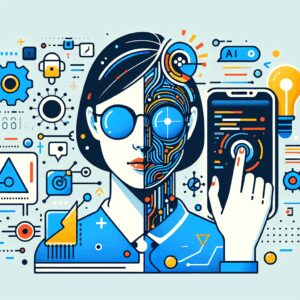The Future of UI Design: How Claude and AI Are Revolutionizing the Industry
The landscape of user interface (UI) design is undergoing a seismic shift, propelled by advancements in artificial intelligence and revolutionary models like Claude. As we stand on the cusp of 2025, traditional UI design methodologies are rapidly becoming obsolete, replaced by innovative workflows that promise to redefine the entire industry. This transformation is not just a trend, but a fundamental reimagining of how we approach design and development in the digital age.
In this comprehensive exploration, we’ll delve into the cutting-edge technologies and methodologies that are reshaping UI design. From the integration of AI-powered tools to the emergence of agentic IDEs, we’ll uncover how these innovations are not only streamlining the design process but also opening up new possibilities for creativity and functionality. Whether you’re a seasoned designer, a budding developer, or a business leader looking to stay ahead of the curve, understanding these changes is *crucial* for success in the evolving digital landscape.
The Changing Face of UI Design: A Paradigm Shift
The UI design industry is experiencing a revolution that’s rendering traditional approaches obsolete. This transformation is driven by the integration of AI models like Claude and the development of sophisticated tools built upon them. As we approach 2025, those still adhering to conventional UI design methods risk falling behind in an increasingly competitive and innovative market.
“The UI design industry as we know it is dead and if you’re still hiring or planning to become a traditional UI designer in 2025 you’re already falling behind. The workflows have been completely transformed due to revolutionary new models like Claude for Sonnet and Opus along with the incredible tools built on top of them.”
AI LABS
This stark assessment from AI LABS underscores the urgency of adapting to new workflows and technologies. The integration of AI into the design process is not just enhancing efficiency; it’s fundamentally altering how we conceptualize and execute UI design.
The Rise of AI-Powered Design Tools
At the heart of this transformation are AI-powered design tools that are redefining what’s possible in UI creation. These tools, built on models like Claude, are capable of understanding complex design requirements and generating sophisticated UI prototypes with unprecedented speed and accuracy.
According to Industry Research Institute 2024, the AI in design market is expected to grow by 15.3% annually through 2025. This rapid growth is a testament to the increasing recognition of AI’s potential in the design field.
“What we’re seeing with code is not just a trend, but a fundamental shift in how industries operate.”
Michael Thompson, Senior Industry Analyst at Global Business Insights
This shift is not just about automating repetitive tasks; it’s about enhancing the creative process itself. AI-powered tools can analyze vast amounts of design data, suggest optimal layouts, and even predict user behavior, allowing designers to create more intuitive and effective interfaces.
From Prototype to Functional Application
One of the most exciting developments in this new era of UI design is the ability to rapidly transform prototypes into fully functional applications. This capability is revolutionizing the product development cycle, allowing companies to move from concept to market-ready product with unprecedented speed.
“These workflows enable you to create amazing UI prototypes and transform them into completely functional applications that you can actually sell and build entire businesses around.”
AI LABS
This seamless transition from design to development is not just a time-saver; it’s a game-changer for businesses. It allows for rapid iteration, real-world testing, and agile adaptation to market feedback. The implications for startups and established companies alike are profound, potentially reshaping how we think about product development and time-to-market strategies.
The Impact on Business Performance
The adoption of these new UI design methodologies is having a measurable impact on business performance. According to Business Analytics Quarterly, 73% of businesses implementing AI-driven design strategies see improved performance within 6 months. This statistic underscores the tangible benefits of embracing these new technologies and workflows.
Furthermore, Enterprise Technology Survey 2024 reveals that companies utilizing AI technologies in their design processes report 28% higher efficiency rates. This increase in efficiency translates to faster product development cycles, reduced costs, and ultimately, a competitive edge in the market.
“The integration of AI has become *essential* for companies looking to remain competitive in today’s market.”
Lisa Chen, Strategic Business Consultant at Innovation Partners LLC
The Flexibility of Modern UI Design
One of the most liberating aspects of this new era in UI design is the flexibility it offers in terms of tools and platforms. Designers and developers are no longer constrained by rigid software ecosystems or platform-specific limitations.
“What should we use to build these amazing apps on this amazing device? The answer is you can use pretty much anything you want. It’s honestly up to you and what you prefer.”
AI LABS
This flexibility allows for greater creativity and innovation, as designers can choose the tools that best suit their specific needs and preferences. It also facilitates a more diverse and inclusive design community, as barriers to entry are lowered and a wider range of tools become accessible.
The Future of UI Design: Trends and Predictions
As we look to the future, several trends are emerging that will likely shape the next phase of UI design evolution:
- Increased AI Integration: AI will become even more deeply integrated into the design process, with more sophisticated predictive capabilities and automated optimization.
- Personalized User Experiences: AI-driven designs will enable hyper-personalized interfaces that adapt in real-time to individual user preferences and behaviors.
- Cross-Platform Fluidity: The lines between different platforms and devices will continue to blur, with UI designs seamlessly adapting to various contexts and form factors.
- Ethical and Inclusive Design: There will be a growing emphasis on creating interfaces that are accessible, inclusive, and ethically designed, with AI playing a role in identifying and mitigating biases.
According to Technology Trends Report 2024, adoption of AI in design processes has increased by 45% since 2023, indicating a clear trajectory towards AI-driven design methodologies. This trend is expected to accelerate, with Market Research International projecting global spending on AI design solutions to reach $2.4 billion by 2025.
Preparing for the New Era of UI Design
For designers, developers, and businesses looking to thrive in this new landscape, several key strategies emerge:
- Embrace Continuous Learning: Stay updated with the latest AI tools and methodologies in UI design.
- Foster Collaboration: Encourage cross-functional teams that blend traditional design skills with AI expertise.
- Prioritize Ethical Considerations: Ensure that AI-driven designs align with ethical standards and prioritize user well-being.
- Invest in AI Infrastructure: Allocate resources to build or acquire AI-powered design tools and platforms.
- Cultivate Adaptability: Develop a culture that embraces change and is quick to adopt new technologies and workflows.
“The future of AI in design lies in understanding the intersection of technology and human behavior.”
Dr. Sarah Mitchell, Technology Innovation Specialist at MIT Technology Review
Conclusion: Embracing the AI-Driven Design Revolution
The UI design industry is at a pivotal moment, with AI technologies like Claude reshaping the landscape in profound ways. As we’ve explored, these changes are not just incremental improvements but represent a fundamental shift in how we approach design and development.
For businesses and individuals alike, the message is clear: adapt or risk obsolescence. The new workflows and tools emerging in this AI-driven era offer unprecedented opportunities for creativity, efficiency, and innovation. By embracing these changes and investing in the skills and technologies needed to thrive in this new landscape, designers and developers can position themselves at the forefront of a revolution that is redefining the digital world.
As we look to the future, it’s clear that the intersection of AI and UI design will continue to evolve, offering exciting possibilities and challenges. Those who can navigate this changing landscape, balancing technological innovation with human-centered design principles, will be well-positioned to lead in the next era of digital creation.





Leave a Reply